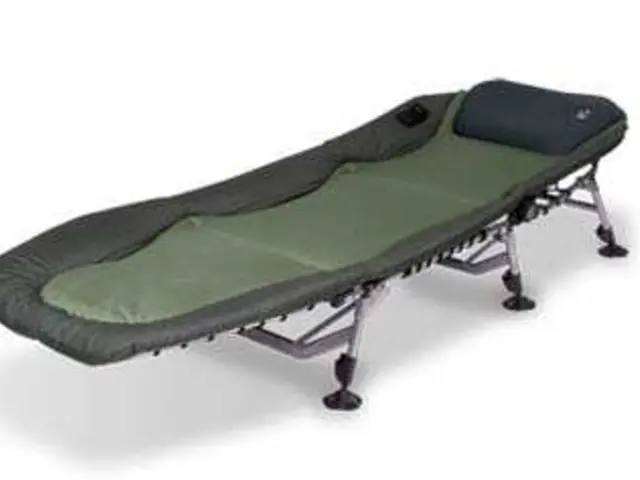Aid devices: Determining when to utilize walkers over canes, or vice versa.
Navigating the frontier of aging and mobility, canes and walkers serve as reliable allies for older adults and those living with disabilities grappling with balance and mobility issues. But, the choice between these mobility aids depends on the degree of support required, individual lifestyle, and budget constraints.
The golden years bring the lurking risks; according to the Centers for Disease Control and Prevention (CDC), falls in the elderly can lead to significant injuries in older age. Utilizing assistive devices is an effective means to mitigate these risks, allowing individuals to maintain their independence and dodge the dreaded tumble.
Two main categories of assistive mobility devices - wheelchairs and canes/walkers - cater to varying levels of mobility. Wheelchairs are ideal for those with no or limited mobility, while canes and walkers are tailored for those with some mobility to lean on.
Our piece delves into the intricacies of canes and walkers, comparing their advantages, setbacks, conditions, and prices.
Unearth the fundamental contrasts between walkers and canes below:
| Device | Pros | Cons | Conditions | Cost ||-------------|------------------------------------------------------------------------|---------------------------------------------------------------------------|--------------------------------------------------------|-------------|| 1-legged Cane | - Aids balance | - Suitable only for minimal weight bearing | - Mild balance issues, mild to moderate arthritis of the lower limbs | $10-$40 || 3-4 legged Cane | - Enhances balance, bears more weight | - Heavier, more cumbersome, challenging on stairs | - One-sided muscle weakness, more significant balance issues | $15-$40 || Standard Walker | - Stable, foldable | - Requires lifting with each step | - Conditions affecting muscle or nerve function, fractures | $20-$60 || 2-4 wheeled Walker | - Easier to move, may have a seat and basket for comfort | - Less stable than standard, not foldable | - Issues affecting the spinal cord, slower mobility due to heart or lung diseases | $35-$100 |
-helps with balance-adjustable
The Medical Landscape: Cane or Walker?
-for minimal weight bearing only-some have a curved handle that some may find difficult to grasp and cause pain, especially for people with joint or muscle conditions
Canes and walkers provide stability during mobility. Canes can assist individuals with minor balance or stability issues, thigh or trunk weakness, or ailments like arthritis.
-mild balance issues-mild to moderate arthritis of the lower limbs
A person typically grips a cane with one hand, and depending on the type, it can be single-legged or have three or four legs. The more legs a cane has and the broader its base, the more stability it supplies. Suffering from total knee or hip replacement or experiencing more substantial balance and mobility issues might call for a walker instead.
$10-$40
This three- to four-legged device necessitates the use of both hands, offering additional support and comfort with wrist or arm support and various accessories like wheels or brakes.
Genre of Canes and Walkers
-offers greater help with balance than a standard cane-can bear more weight-adjustable
The standard cane is typically wood or aluminum, featurings a rubber tip, hook-shaped or flat handle. It best suits those needing minimal assistance but may be unsuited for those requiring extra support.
-heavier-more cumbersome-may be harder to use on stairs
Canes boasting three or four legs can stand independently, providing greater stability for individuals experiencing pain on one side. Other multi-legged canes, known as "sit-to-stand" canes, feature a secondary grip, offering additional support for getting up or sitting down.
-one-sided muscle weakness (hemiparesis) or more significant issues with balance
Know three types of walkers, catering to individual needs:
$15-$40
- The standard walker with four rubber-tipped legs offers superior stability but demands each step to be lifted.
- The two-wheeled walker with front wheels and backsliders is simpler to maneuver but is less stable and requires cognitive effort to handle.
- The four-wheeled walker (rollator) enables a more natural gait, featuring brakes, a seat, and a basket. However, it may be heavier and requires more coordination.
Each walker type offers benefits and drawbacks based on the person's specific needs and capabilities.
-stable-foldable
Canes or Walkers? The Great Debate
-no wheels-needs lifting with each step
Effectively using a cane necessitates possessing enough strength to walk consistently with it, maintaining balance, and securing oneself if necessary. While a cane can help with minor balance problems, it presumes the individual can adapt to shifting conditions.
-for conditions that affect the function of muscles or nerves or for fractures
Walkers, on the other hand, are preferable when the individual confronts more substantial balance impairments. Walkers possess four legs, allowing users to distribute some or all of their body weight away from their lower body while moving.
$20-$60
Using a walker, an individual can rely on their arms to support their body weight, and as their strength and endurance improve, they can place more weight on their legs. Regardless of wheels, a walker is more appropriate for indoor or outdoor usage, depending on the terrain one needs to navigate.
When to Trade In: Cane vs. Walker
-easier to move-may have a seat and basket for comfort
Determining when to switch from a walker to a cane or vice versa involves several factors. One should ponder:
-less stable than standard-not foldable
- Is balance improving or worsening?
- Have strength and endurance levels changed?
- What does the doctor recommend?
- Is the daily routine more suited to a walker or a cane?
-issues affecting the spinal cord, conditions that slow down mobility like heart or lung diseases
Where to Acquire Your Mobility Aid
$35-$100
One may purchase a preferred mobility aid directly from a supplier or access them through a clinic, hospital, insurance company, or non-profit organization for older adults or the disabled.

Affordability: A Can vs. A Walker
Canes generally cost between $10 and $40. Walkers tend to be pricier, ranging from $20 to $100.
DME and Medicare
Medicare recognizes walkers and canes as Durable Medical Equipment (DME). Individuals can rent or purchase a cane or walker through Medicare Part B if it is deemed medically necessary and utilized in the home.
Safety First
Regardless of the preferred mobility aid, ensuring safe usage is paramount. Both canes and walkers require the handle to be wrist-height, relaxed arms, and slightly bent arms while using.
Cane Safety
When standing, grasp the cane with the hand opposite the injured or painful side. While walking, place the cane ahead, step forward with the painful or injured leg, and trail behind with the other leg.
Using stairs, use the stronger leg first when ascending, holding on to the handrail. While descending, place the cane first, then the weaker leg, followed by the stronger one.
Walker Safety
When utilizing a walker, place it one step ahead, move the injured or painful leg to the middle, and then bring the stronger leg to meet it, taking small, slow steps.
The safest means to sit is to back up to the chair, feel for the seat, and lower oneself slowly. To stand, use arms and grasp the walker's handgrips. Do not rely on the walker to assist with standing up as it may fail. It is generally best not to use a walker on stairs or escalators.
Summing Up
Aging brings on certain chronic conditions that make mobility a challenge. Each year, 1 in 4 older adults fall, potentially causing severe injuries to their muscles and bones.
However, employing assistive devices is indispensable in safeguarding independence, offering support during recovery, and reducing the odds of tumbling. Canes and walkers play crucial roles in aiding individuals with some degree of mobility.
Between these two mobility aids, the decision boils down to the needed level of support, individual lifestyle, and financial constraints. Consulting healthcare professionals like physical therapists will help determine the most appropriate mobility aid.
- Categorizing senior health solutions, canes and walkers are uncategorized under-science-medical-conditions-chronic-diseases, but form a significant part of the health-and-wellness field, addressing mobility issues arising from aging.
- These devices play a vital role in maintaining independence for those aging by mitigating risks associated with falls, a common concern for seniorhealth.
- The mobility landscape for seniors offers solutions like wheelchairs, but canes and walkers cater to varying degrees of mobility, serving as reliable allies for those with some form of balance or mobility difficulties.
- The choice between canes and walkers depends on the specific medical-conditions-chronic-diseases-aging-seniorhealth experienced, level of mobility, budget, and personal fitness-and-exercise preferences.
- The science behind canes and walkers delves into their advantages, disadvantages, associated conditions, and prices, ultimately helping individuals make informed decisions about their health-and-wellness.
- Engaging in sports-analysis and proper nutrition is integral to managing chronic diseases, leading to better recovery and mobility, and younger-acting aging. CBD may also offer potential benefits for senior-health, reducing inflammation associated with conditions like arthritis and promoting fitness-and-exercise.








